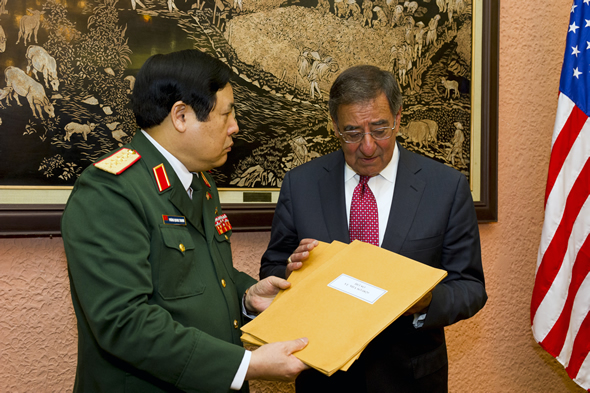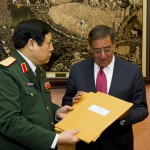

US Defense Secretary Leon Panetta, speaking before representatives of Asia-Pacific nations attending the Shangri-La Security Dialogue symposium in Singapore on 2 June, offered a broad outline of US plans to strengthen US naval forces deployed to the Pacific region.
Secretary Panetta, on an eight-day tour of the Asia-Pacific region, used his speaking opportunity at the 11th Asia Security Summit to outline US plans for a revised defense strategy, military realignment, and strengthening of long-term relationships that emphasize America’s commitment to the Asia-Pacific/Indian Ocean region.
The projected “pivot” of US attention to the Asia-Pacific region was announced by President Obama last year and a Pentagon strategic guidance policy statement in January affirmed US plans to renew and strengthen the nation’s historic link to the Pacific by means of military realignments, renewal of relations with vital Asia-Pacific partners, and creation of new relationships with other nations in the region.
Secretary Panetta’s trip is expected to garner support for the new US strategy and to reassure America’s Pacific allies that the US is truly committed to creating a stronger presence in the region. In a public statement made enroute to Singapore, Panetta said the United States was firmly committed to building “a region that enjoys peace, prosperity, security, and stability.”
In generally broad strokes, the Secretary outlined the framework of a military realignment of US forces to the Asia-Pacific region during his speech. He indicated that an estimated 60 percent of the US Navy fleet would be committed to the Pacific by 2020. He said that the United States will maintain a naval force in the Pacific to “include six aircraft carriers in this region, a majority of our cruisers, destroyers, Littoral Combat Ships, and submarines.”
Currently the US has 11 active carrier strike groups with six dedicated primarily to Pacific duties – two homeported in California, three located in Washington State, and one forward deployed to Yokosuka, Japan. Should the USS Enterprise be retired later this year as scheduled, the Pacific Fleet would be reduced to five operational carrier strike groups. It is unknown if another group might be relocated as a replacement for the Enterprise group, an expensive and time-consuming endeavor, or if the Pacific Fleet will operate only five groups until the USS Gerald R. Ford is ready for service. The Ford is scheduled to be completed in 2015.
As of March this year, the US Navy had an active fleet of 282 ships. This number is expected to drop to 276 ships during the next two years. After that, more ships are scheduled to enter service as the Navy works toward its 30-year goal of fielding a 300-ship fleet. Pentagon officials have been forthcoming in their warnings that economic woes, excessive cost overruns, and fiscal constraints pose serious obstacles to achieving this goal.
While acknowledging the US faced severe budget reductions, Secretary Panetta stated that the Department of Defense budget plan included a “detailed blueprint for implementing this strategy, realizing our long-term goals in this region and still meeting our fiscal responsibilities.”
The Secretary stated that, “over the next five years we will retire older Navy ships, but we will replace them with more than 40 far more capable and technologically advanced ships.” He also outlined the Pentagon’s plan to “increase the number and the size of our exercises in the Pacific.” In 2011, the US conducted 172 joint training exercises with other nations in the region. The new defense strategy will also involve a wider distribution and more frequent schedule of Pacific port visits to include ports in the Indian Ocean.
Mr. Panetta told the audience that the United States had firm plans in place to invest in new and emerging technologies to maintain US military capabilities. He mentioned that the US will be investing in “an advanced fifth-generation fighter, an enhanced Virginia-class submarine, new electronic warfare and communications capabilities, and improved precision weapons — that will provide our forces with freedom of maneuver in areas in which our access and freedom of action may be threatened.”
Secretary Panetta emphasized the far-reaching extent of America’s commitment to the Pacific in his comments. He highlighted the US agreements and alliances that have created long-term partnerships with Japan, South Korea, Taiwan, Australia, the Philippines, and Thailand. He also stressed America’s determination to forge similarly strong bonds of friendship and cooperation with Singapore, New Zealand, Indonesia, Malaysia, India, and Vietnam.
In his comments, Mr. Panetta said he was familiar with claims that the US shift in emphasis was undertaken as a counterbalance to China’s growing economic and military influence in the Pacific and responded to these allegations by saying, “I reject that view entirely. Our effort to renew and intensify our involvement in Asia is fully compatible with the development and growth of China.”
He went on to say that an increased US presence in the region “will benefit China as it advances our shared security and prosperity for the future.” He continued in this vein by stating that he was “personally committed to building a healthy, stable, reliable, and continuous military-to-military relationship with China.”
Panetta’s trip through the Pacific comes during a period of unrest and tense territorial disputes in the South China Sea between Beijing and her Pacific neighbors that have revived regional distrust and fear of China’s intentions. In his speech, Secretary Panetta said that “China has a critical role to play in advancing security and prosperity by respecting the rules-based order that has served the region for six decades.” He emphasized the importance of regional neighbors working together to resolve disputes peacefully while guaranteeing that regional rights are protected.
During this tour, Secretary Panetta is accompanied by the US Chairman of the Joint Chiefs of Staff (CJCS), General Martin Dempsey, and commander of the US Pacific Command, Admiral Samuel Locklear. In Singapore, China appeared to make a point of displeasure with America’s renewed focus on the Asia-Pacific region by sending a less illustrious team of representatives. The Chinese delegation, unlike last year, was headed by the Vice President of the Academy of Military Sciences and did not include Defense Minister Liang Guanglie.
Following stops in Hawaii and Singapore, Secretary Panetta is scheduled to visit Vietnam and India for high-level strategic and economic discussions. The Secretary also said he would be making a trip to China in the near future. General Dempsey will also be holding discussions with representatives of other Asia-Pacific nations to further explain US plans for the region.
















